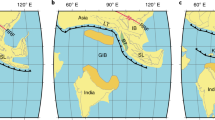Abstract
The Juan de Fuca, Rivera, Cocos and Nazca plates in the eastern Pacific are small fragments remaining from the fragmentation and partial subduction of the long, narrow Farallon Plate which began as early as 55 Myr ago1. This fragmentation apparently resulted from interaction of the very irregular Pacific–Farallon ridge with the uneven coastlines of the American Plate1–4 and involved the formation of ridge–trench transforms5, creation of new spreading centres6, ridge jumps1,7,8, deactivation of subduction zones2 and other phenomena1. We present here magnetic evidence that a fifth small fragment of the Farallon plate is preserved in the eastern Pacific off the coast of Baja, California. Its preservation is the result of an eastward jump of the Pacific–Farallon ridge ∼12.5 Myr ago which was preceded by asymmetric spreading and perhaps pivotal subduction1. Menard1 first suggested this idea and showed that anomaly 5B is symmetric and parallel to a linear trough trending southwards from Guadalupe Island. He named the small fragment of the Farallon plate preserved between this trough and the margin of Baja California to the east, the Guadalupe plate1. We show that both anomalies 5B and 5C symmetrically flank the Guadalupe trough. Our results and conclusions are not based on new magnetic data, but rather on reinterpretation of aeromagnetic profiles published by Taylor et al.9.
This is a preview of subscription content, access via your institution
Access options
Subscribe to this journal
Receive 51 print issues and online access
$199.00 per year
only $3.90 per issue
Buy this article
- Purchase on Springer Link
- Instant access to full article PDF
Prices may be subject to local taxes which are calculated during checkout
Similar content being viewed by others
References
Menard, H. W. J. Geol. 86, 99–110 (1978).
Atwater, T. Bull. geol. Soc. Am. 86, 3513–3536 (1970).
Herron, E. M. Bull. geol. Soc. Am. 83, 1671–1692 (1972).
Handschumacher, D. W. Geophys. Mongr. 19, 177–202 (1976).
Molnar, P. Bull. geol. Soc. Am. 84, 1651–1658 (1973).
Herron, E. M. & Heirtzler, J. R. Science 158, 775–780 (1967).
Anderson, R. N. & Davis, E. E. Nature 241, 191–193 (1973).
Sclater, J. G., Anderson, R. N. & Bell, M. L. J. geophys. Res. 76, 7888–7915 (1971).
Taylor, P. T., Brennan, J. A. & O'Neill, N. J. Nature 229, 396–399 (1971).
Krause, D. C. Bull. geol. Soc. Am. 76, 617–650 (1965).
Chase, C. G., Menard, H. W., Larson, R. L., Sharman, G. F. & Smith, S. M. Bull. geol. Soc. Am. 81, 491–498 (1970).
Spudich, P. & Orcutt, J. J. geophys. Res. 85, 1409–1433 (1980).
Blakely, R. J. J. geophys. Res. 79, 2974–2985 (1974).
Batiza, R. Geology 5, 760–764 (1977).
Author information
Authors and Affiliations
Rights and permissions
About this article
Cite this article
Batiza, R., Chase, C. Miocene spreading centre south of Isla Guadalupe. Nature 289, 787–789 (1981). https://doi.org/10.1038/289787a0
Received:
Accepted:
Issue Date:
DOI: https://doi.org/10.1038/289787a0
Comments
By submitting a comment you agree to abide by our Terms and Community Guidelines. If you find something abusive or that does not comply with our terms or guidelines please flag it as inappropriate.



